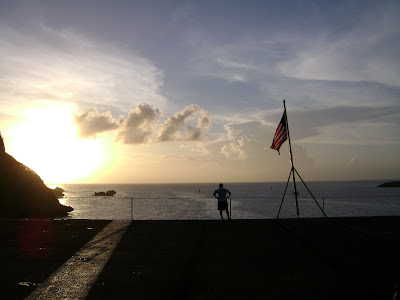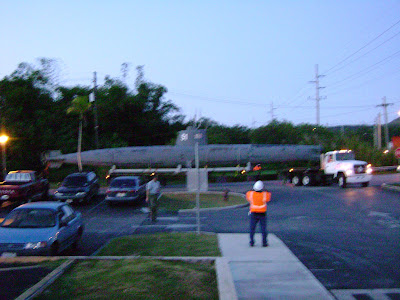On my second day on Guam, after picking up garbage all morning, James took me out to his friend Dan to see a car he had for sale – for $500. We drove north on Marine Drive. I see the car as we drive up to the house. James says, “Hey it has wheels.” Dan gives me the key and I take it out for a test drive.

It is a 1988 Mitsubishi Mirage 2 door fully equipped with
- automatic transmission,
- steering wheel,
- windows,
- one side mirror,
- extensive rust,
- two bowling balls (?),
- bumper attached by bailing wire,
- a large ant colony.
I took it out for a spin and although the doors didn’t lock, the air con didn’t work, the windows took herculean effort to roll down, and the brakes took a few minutes to slow the car down, it did drive forward at slow speeds. After the drive, I offered $450 and Dan took it. Thinking back, I have to ask myself why the hell did I buy that thing? I was desperate. I just needed basic transportation that would last until I got a few paychecks in the bank to upgrade. What I got was a big mistake.
After the purchase, James followed me in my rental car to drop it off. After turning in the rental car, we jumped into my new “Guam Bomb.” But, it didn’t start; it didn’t even try to turn over. I owned the car less than 20 minutes and it was already broke down. The rental car mechanic, Rick, took a look at it and gave a summary diagnosis – “it sounds like the starter’s dead.” Rick agreed to look at it the next day. James and I got back into the rental car and left. The next day, after my first day at work, I went back to see Rick. Unfortunately, Rick hadn’t found the time to look at it. He promised he would move it two blocks away to the rental car garage on Tuesday (the next day). I called Rick on Tuesday and he said that it was indeed the starter. That night I called Dan to see what he would be willing to do. Dan had been explicit before the transaction that the car was “as is” so I did not expect him to take the car back. To his credit, Dan did offer to split the cost of the repair. I called Rick again on Wednesday to get an update. He was having difficulty finding a starter for the car. Car parts are not found in great abundance on Guam, especially car parts for vehicles other than the predominant Toyotas and Nissans. Rick called me back on Thursday to report he had obtained a rebuilt starter and would be finished later that day, but wanted to show me another car he had for sale. Rick was trying to sell a ’91 Cadillac Deville. After showing me what he and his coworker Bruno had done to replace, Bruno then went over the laundry list of additional things that need to be done. The radiator leaked, the brakes needed work, the ignition switch needed to be replaced, and on and on. They recommended that I take it back if I could – they would have nothing more to do with it.

But Rick was persuasive with his Cadillac. Not only did it start and run, but “this is no Guam Bomb,” Rick assured me. It ran very smoothly and braked well. Rick needed money immediately and agreed to multiple payments totaling $1,500 in exchange for the car. He also promised to stand behind the Cadillac if it broke down immediately. So I bought the Cadillac, still unsure of how I was ever going to rid myself of the Mitsubishi.
It also dawned on me that I still own two more cars in the states, a Ford Ranger in California and a Mercedes Benz in Tennessee. I own four cars?

 After paying Rick an initial payment of $800 plus $200 for fixing the starter on the Mitsubishi, I realized how utterly broke I was. Long before my arrival on Guam, I had been leaking money like the Exxon Valdez. Not only was I required to pay my way to Guam, but I had to take care of all my incidental expenses once I arrived. I was near the braking point and I hadn't even found a place to live.
After paying Rick an initial payment of $800 plus $200 for fixing the starter on the Mitsubishi, I realized how utterly broke I was. Long before my arrival on Guam, I had been leaking money like the Exxon Valdez. Not only was I required to pay my way to Guam, but I had to take care of all my incidental expenses once I arrived. I was near the braking point and I hadn't even found a place to live.
Early the next week, I called Dan to get 1/2 of the repair costs that he promised to pay. To my surprise and elation, Dan offered to take the car back and call it even (loss of $200 to me). YES! One car down. On the same day, my Dad left two messages on my cell phone. The first one: "Ben, this is Dad, I think I have someone interested in buying your car. Call me back as soon as you can." What an amazing turn of events! I need to call Dad immediately. The next message: "Ben, this is Dad. I sold your car. Give me a call back."
So as quickly as I had amassed four cars and dire financial straights, I had got rid of two and temporarily settled my money woes.
 On my way back from the hash last night I spotted a snake on the road. It was the notorious brown tree snake. This was the first time I have seen the hated snake and many of my coworkers that have been on Guam for years have still never seen them. The brown tree snake arrived on Guam during or shortly following World War II. The exotic species was the first snake ever to slither through Guam's beautiful jungles and the island would never be the same. Over the past 50 years, the brown tree snake has decimated the bird population. There are practically no birds on the island. The only birds I have seen are a few swallows - an exotic species from Europe.
On my way back from the hash last night I spotted a snake on the road. It was the notorious brown tree snake. This was the first time I have seen the hated snake and many of my coworkers that have been on Guam for years have still never seen them. The brown tree snake arrived on Guam during or shortly following World War II. The exotic species was the first snake ever to slither through Guam's beautiful jungles and the island would never be the same. Over the past 50 years, the brown tree snake has decimated the bird population. There are practically no birds on the island. The only birds I have seen are a few swallows - an exotic species from Europe.  The White Throated Ground Dove: Extirpated from Guam
The White Throated Ground Dove: Extirpated from Guam The Bridle White-Eye : Extirpated from Guam
The Bridle White-Eye : Extirpated from Guam Cardinal Honey eater: Extirpated from Guam
Cardinal Honey eater: Extirpated from Guam Nightingale Reed-warbler: Extirpated from Guam
Nightingale Reed-warbler: Extirpated from Guam Guam Rail: Endangered
Guam Rail: Endangered Rufous Fantail: Extinct
Rufous Fantail: Extinct Marianas Fruit Dove: Extirpated from Guam
Marianas Fruit Dove: Extirpated from Guam Micronesian Kingfisher: Exists only in captivity
Micronesian Kingfisher: Exists only in captivity Guam Flycatcher: Extinct
Guam Flycatcher: Extinct













.JPG)


 Just think what I could do if I had a decent camera...
Just think what I could do if I had a decent camera...









 We continue on to the waterfall, but after a while, Bret admits to leading us in the wrong direction. We move overland, finally leaving behind established trails. It is not easy. The local grass is known as sword grass and for good reason - the sides of the long leaves can cut you very easily and it can grow to over eight feet high. Bret and his friends pull out gloves, but I have none. Very soon my hands and legs are cut from the razor sharp edges of the sword grass. Pushing and manhandling your way through dense grass is an intense workout. Very soon I am exhausted. After a long struggle through heavy growth, we realize that we have gone in a large circle - right back where we started. We head back to the last tank to retrace our steps, the tank is visible on the horizon. From there, Bret finds the correct route. After a few minutes, we see the waterfall. It appears to flow into a deep hole in the earth. Bret explains that in the wet season this is an enormous waterfall with a huge volume of water, but today, in the middle of the dry season, it is but a trickle.
We continue on to the waterfall, but after a while, Bret admits to leading us in the wrong direction. We move overland, finally leaving behind established trails. It is not easy. The local grass is known as sword grass and for good reason - the sides of the long leaves can cut you very easily and it can grow to over eight feet high. Bret and his friends pull out gloves, but I have none. Very soon my hands and legs are cut from the razor sharp edges of the sword grass. Pushing and manhandling your way through dense grass is an intense workout. Very soon I am exhausted. After a long struggle through heavy growth, we realize that we have gone in a large circle - right back where we started. We head back to the last tank to retrace our steps, the tank is visible on the horizon. From there, Bret finds the correct route. After a few minutes, we see the waterfall. It appears to flow into a deep hole in the earth. Bret explains that in the wet season this is an enormous waterfall with a huge volume of water, but today, in the middle of the dry season, it is but a trickle. 
 We veer down into the steep river valley. This is a very popular destination, clearly demonstrated by the heavily eroded path and the dozens of ropes attached to trees to help with the
We veer down into the steep river valley. This is a very popular destination, clearly demonstrated by the heavily eroded path and the dozens of ropes attached to trees to help with the 

 It is a 1988 Mitsubishi Mirage 2 door fully equipped with
It is a 1988 Mitsubishi Mirage 2 door fully equipped with

 After paying Rick an initial payment of $800 plus $200 for fixing the starter on the Mitsubishi, I realized how utterly broke I was. Long before my arrival on Guam, I had been leaking money like the Exxon Valdez. Not only was I required to pay my way to Guam, but I had to take care of all my incidental expenses once I arrived. I was near the braking point and I hadn't even found a place to live.
After paying Rick an initial payment of $800 plus $200 for fixing the starter on the Mitsubishi, I realized how utterly broke I was. Long before my arrival on Guam, I had been leaking money like the Exxon Valdez. Not only was I required to pay my way to Guam, but I had to take care of all my incidental expenses once I arrived. I was near the braking point and I hadn't even found a place to live. 



